
Stock Trading Books
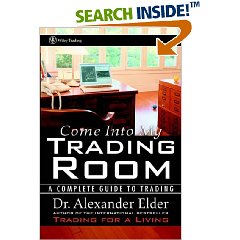 Come Into My Trading Room - In Come Into My Trading Room, noted trader and author Dr. Alexander Elder returns to expand far beyond the three M's (Mind, Method, and Money) of his bestselling
Trading for a Living. Shifting focus from technical analysis to the overall management of a trader's money, time, and strategy, Dr. Elder takes readers from the fundamentals to the secrets of being
a successful trader--identifying new, little known indicators that can lead to huge profits. Come Into My Trading Room educates the novice and fortifies the professional through expert advice and
proven trading methodologies. This comprehensive trading guide provides a complete introduction to the essentials of successful trading; a fresh look at the three M's, including a proven, step-by-step
money management strategy; and an in-depth look at organizing your trading time. Come Into My Trading Room reviews the basics of trading stocks, futures, and options as well as crucial psychological
tactics for discipline and organization—with the goal of turning anyone into a complete and successful trader. By showing traders how to combine the elements of mind, method, and money, Come Into My
Trading Room gives readers the knowledge and insight to enter the market with confidence and exit with profits. Unparalleled depth and a wide range of coverage will keep all levels of traders engaged,
informed, and returning to Come Into My Trading Room again and again.
Come Into My Trading Room - In Come Into My Trading Room, noted trader and author Dr. Alexander Elder returns to expand far beyond the three M's (Mind, Method, and Money) of his bestselling
Trading for a Living. Shifting focus from technical analysis to the overall management of a trader's money, time, and strategy, Dr. Elder takes readers from the fundamentals to the secrets of being
a successful trader--identifying new, little known indicators that can lead to huge profits. Come Into My Trading Room educates the novice and fortifies the professional through expert advice and
proven trading methodologies. This comprehensive trading guide provides a complete introduction to the essentials of successful trading; a fresh look at the three M's, including a proven, step-by-step
money management strategy; and an in-depth look at organizing your trading time. Come Into My Trading Room reviews the basics of trading stocks, futures, and options as well as crucial psychological
tactics for discipline and organization—with the goal of turning anyone into a complete and successful trader. By showing traders how to combine the elements of mind, method, and money, Come Into My
Trading Room gives readers the knowledge and insight to enter the market with confidence and exit with profits. Unparalleled depth and a wide range of coverage will keep all levels of traders engaged,
informed, and returning to Come Into My Trading Room again and again.
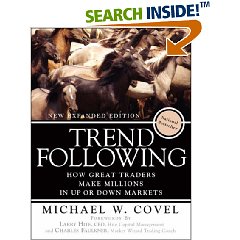 Trend Following - How did John W. Henry quietly become rich enough to buy the Boston Red Sox? How have traders like Keith Campbell, Bill Dunn, Jerry Parker, and Salem Abraham consistently
generated immense wealth in bull and bear markets? The key is trend following -- the only strategy proven to consistently make money. Now, one of the field's leading experts pulls back the veil on
trend following, showing how it works and how you can take advantage of it. Michael Covel reveals the "underground" network of little-known traders and hedge fund managers who've been using trend
following for decades. He introduces its fundamental concepts and techniques, showing why market prices contain all the information investors need, and how to understand price movements well enough
to profit from them. Using 100 pages of easy-to-understand charts from top trend followers, Covel proves the strategy works -- and shows why only a technical system based on following price trends
can win over the long term. Covel presents more than a decade's worth of data: information you'd otherwise pay a fortune to see presented this clearly. He also shows even more backtested trend
following results, so you can gain even greater confidence in the method. Along the way, Covel thoroughly debunks misinformation and failed advice from pros who ought to know better. This timely
book capitalizes on today's intense volatility and uncertainty to give investors what they're desperately searching for: a strategy that really works.
Trend Following - How did John W. Henry quietly become rich enough to buy the Boston Red Sox? How have traders like Keith Campbell, Bill Dunn, Jerry Parker, and Salem Abraham consistently
generated immense wealth in bull and bear markets? The key is trend following -- the only strategy proven to consistently make money. Now, one of the field's leading experts pulls back the veil on
trend following, showing how it works and how you can take advantage of it. Michael Covel reveals the "underground" network of little-known traders and hedge fund managers who've been using trend
following for decades. He introduces its fundamental concepts and techniques, showing why market prices contain all the information investors need, and how to understand price movements well enough
to profit from them. Using 100 pages of easy-to-understand charts from top trend followers, Covel proves the strategy works -- and shows why only a technical system based on following price trends
can win over the long term. Covel presents more than a decade's worth of data: information you'd otherwise pay a fortune to see presented this clearly. He also shows even more backtested trend
following results, so you can gain even greater confidence in the method. Along the way, Covel thoroughly debunks misinformation and failed advice from pros who ought to know better. This timely
book capitalizes on today's intense volatility and uncertainty to give investors what they're desperately searching for: a strategy that really works.
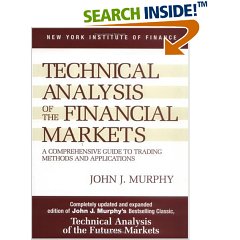 Technical Analysis of the Financial Markets - This outstanding reference has already taught thousands of traders the concepts of technical analysis and their application in the futures and
stock markets. Covering the latest developments in computer technology, technical tools, and indicators, the second edition features new material on candlestick charting, intermarket relationships,
stocks and stock rotation, plus state-of-the-art examples and figures. From how to read charts to understanding indicators and the crucial role technical analysis plays in investing, readers gain a
thorough and accessible overview of the field of technical analysis, with a special emphasis on futures markets. Revised and expanded for the demands of today's financial world, this book is essential
reading for anyone interested in tracking and analyzing market behavior.
Technical Analysis of the Financial Markets - This outstanding reference has already taught thousands of traders the concepts of technical analysis and their application in the futures and
stock markets. Covering the latest developments in computer technology, technical tools, and indicators, the second edition features new material on candlestick charting, intermarket relationships,
stocks and stock rotation, plus state-of-the-art examples and figures. From how to read charts to understanding indicators and the crucial role technical analysis plays in investing, readers gain a
thorough and accessible overview of the field of technical analysis, with a special emphasis on futures markets. Revised and expanded for the demands of today's financial world, this book is essential
reading for anyone interested in tracking and analyzing market behavior.
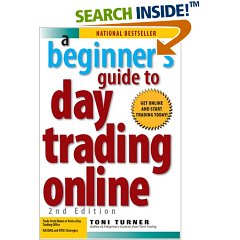 A Beginner's Guide to Day Trading Online - Day trading is highly profitable and highly tumultuous. Moreover, the financial markets have changed considerably in recent years. Expert author Toni
Turner gives you the latest information on mastering the markets, including:
A Beginner's Guide to Day Trading Online - Day trading is highly profitable and highly tumultuous. Moreover, the financial markets have changed considerably in recent years. Expert author Toni
Turner gives you the latest information on mastering the markets, including:
- Decimalization of stock prices
- New trading products such as E-minis and Exchange Traded Funds (ETFs)
- Precision entries and exits
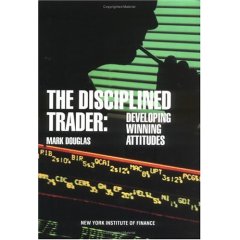 The Disciplined Trader - If you are looking for a answer to your trading psychological problems, this is it!!! This books takes you into a journey of understanding your self and your physical
functions as a primary element of trading success. I have understood where my fear comes from and of course, I have understood that everything is an illusion and that the market cannot do anything
to me.
The Disciplined Trader - If you are looking for a answer to your trading psychological problems, this is it!!! This books takes you into a journey of understanding your self and your physical
functions as a primary element of trading success. I have understood where my fear comes from and of course, I have understood that everything is an illusion and that the market cannot do anything
to me.
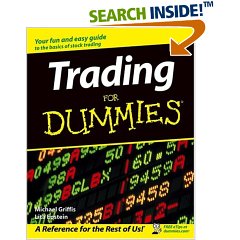 Trading for Dummies - When people think of stock trading, they often think of the glory days of the Internet, when stocks just kept going up and everyone seemed to be making a fortune.
Since the bubble burst, many people are scared of investing in the stock market. Sure, stocks are risky—just like any other investment—but with the right knowledge and tactics, there's still
money to be made.
Trading for Dummies - When people think of stock trading, they often think of the glory days of the Internet, when stocks just kept going up and everyone seemed to be making a fortune.
Since the bubble burst, many people are scared of investing in the stock market. Sure, stocks are risky—just like any other investment—but with the right knowledge and tactics, there's still
money to be made.
Trading For Dummies isn't about high-risk, fast-paced day trading. It's a simple, straightforward guide to the ins and outs of stock investing that offers a measured, level-headed approach to trading. You'll learn the basics of portfolio management, measuring stock value, market analysis, and much more—all with a focus on risk reduction and steady profits. Inside you’ll learn how to:
- Understand market cycles
- Choose a great broker
- Master technical analysis
- Manage your risk exposure
- Build a balanced portfolio
This friendly guide presents the kind of honest advice you won't find in the typical get-rich-quick books on trading. Full of practical tips and tactics as well as hardnosed insider advice this handy resource shows you how to build a strong, balanced, and profitable portfolio. Whether you want to save up for your retirement or pay for college, Trading For Dummies will show you how to:
- Prepare yourself with the right tools and information
- Develop your own custom trading strategy
- Analyze companies and stocks
- Understand all the exchanges and markets
- Understand broker fee structures
- Analyze market behavior
- Decipher income statements, balance sheets, and ratios
- Read charts and graphs
- Spot trends and profit from them
This book has all the tools and honest advice novice stock traders need to get set-up quickly and safely. Basic strategies and stock valuation methodologies let you control your risk exposure and make wise decisions. Trading For Dummies includes everything new traders need with advice on every type of stock or derivative, every kind of trade, and every popular strategy.
 Hot Commodities - According to Jim Rogers, "commodities get no respect." Here are a few reasons why he thinks they should: they are easier to comprehend and study than stocks and behave more
rationally since they are subject to the basic laws of supply and demand; they have outperformed many other investment options in recent years; it is foolish to ignore an entire sector of the
marketplace; and a bull market is currently under way in commodities--a trend that Rogers expects to last for a least a decade longer. Further, Rogers believes that you cannot be a successful
investor in stocks, bonds, or currencies without an understanding of commodities. Hot Commodities: How Anyone Can Invest Profitably in the World's Best Market is designed to introduce the novice
to the basics of investing in commodities as well as explain what they are and why they are important. In doing so, he shatters some myths about the relative risks of commodities, explains the
relationship between the stock and commodities markets, and provides a succinct analysis and history of the global oil, gold, lead, sugar, and coffee markets.
Hot Commodities - According to Jim Rogers, "commodities get no respect." Here are a few reasons why he thinks they should: they are easier to comprehend and study than stocks and behave more
rationally since they are subject to the basic laws of supply and demand; they have outperformed many other investment options in recent years; it is foolish to ignore an entire sector of the
marketplace; and a bull market is currently under way in commodities--a trend that Rogers expects to last for a least a decade longer. Further, Rogers believes that you cannot be a successful
investor in stocks, bonds, or currencies without an understanding of commodities. Hot Commodities: How Anyone Can Invest Profitably in the World's Best Market is designed to introduce the novice
to the basics of investing in commodities as well as explain what they are and why they are important. In doing so, he shatters some myths about the relative risks of commodities, explains the
relationship between the stock and commodities markets, and provides a succinct analysis and history of the global oil, gold, lead, sugar, and coffee markets.
Rogers also offers practical advice and information for beginners, including the best resources, how to read the commodities reports in the newspaper or on television, the various ways to open an account, information on index funds (such as Rogers' own index fund that he started in 1998), mechanisms, terminology, and other vital details people must know before investing. Clearly written and entertaining, Hot Commodities offers a solid introduction to investments that many people, including financial advisors, fail to give the proper respect.
The Intelligent Investor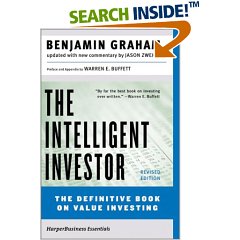
Since it was first published in 1949, Graham's investment guide has sold over a million copies and has been praised by such luminaries as Warren E. Buffet as "the best book on investing ever written." These accolades are well deserved. In its new form--with commentary on each chapter and extensive footnotes prepared by senior Money editor, Jason Zweig--the classic is now updated in light of changes in investment vehicles and market activities since 1972. What remains is a better book. Graham's sage advice, analytical guides, and cautionary tales are still valid for the contemporary investor, and Zweig's commentaries demonstrate the relevance of Graham's principles in light of 1990s and early twenty-first century market trends.
Jim Cramer's Real Money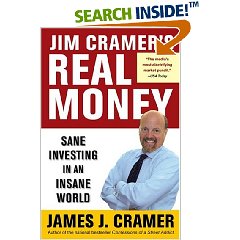
Cramer walks investors through the key decisions they have to make: understanding their tolerance for risk and defining their goals, doing the essential homework on a stock, and knowing how to buy and sell stocks the right way -- the Cramer way. This is a true nuts-and-bolts guide to investing, from Cramer's detailed discussion of the sort of homework investors must do to his own guidelines for knowing when and how to sell stocks.
Mad Money is a hugely entertaining television program, but it also offers valuable information that can be the basis for a winning portfolio. Cramer shows how to turn the "Lightning Round" into a terrific tool for investing; it's stock-market strength training. He reveals how he can assess a stock in only seconds -- a valuable skill that every investor can acquire and put to good use. He explains what to look for in his CEO and CFO interviews, and how to use those conversations to make successful investment decisions. He reviews some of his best calls made on Mad Money, as well as some of his worst ones, to extract ten lessons from each that can profit every investor. And for the Mad Money junkies who just can't get enough, Cramer goes behind the scenes to explain everything from the reason behind his deliberate mispronunciations to his notorious chair abuse to the zany props and buttons that keep things humming.
From the first "Booyah" to the last roar of the bull, Mad Money is every investor's favorite television program, and Jim Cramer's Mad Money is the book that can turn a TV program into a top-notch stock portfolio.
Mastering the Trade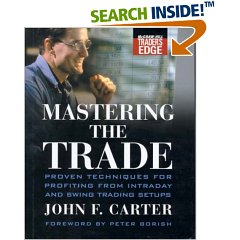
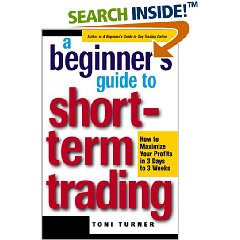 A Beginner's Guide to Short-Term Trading - "A Beginner's Guide to Short-term Trading" is written to those of you who want to profit by grabbing the "sweet spots" out of a stock's uptrend or
downtrend. The book explains two styles of trading: swing trading and position trading. When you place a swing trade, you buy a stock with the intent of taking gains in 2 - 5 days. When you enter
a position trade, you typically buy a stock breaking out of a base into an uptrend. You hold that position as long as the stock rises in that uptrend, approximately 3 - 6 weeks.
A Beginner's Guide to Short-Term Trading - "A Beginner's Guide to Short-term Trading" is written to those of you who want to profit by grabbing the "sweet spots" out of a stock's uptrend or
downtrend. The book explains two styles of trading: swing trading and position trading. When you place a swing trade, you buy a stock with the intent of taking gains in 2 - 5 days. When you enter
a position trade, you typically buy a stock breaking out of a base into an uptrend. You hold that position as long as the stock rises in that uptrend, approximately 3 - 6 weeks.
If you have a have full-time job, yet want to participate in the stock market, short-term trading may appeal to you. And, if you're a traditional buy-and-hold investor, the knowledge you find in this book will help you keep your profits, instead of gaining them . . . and then giving them back.
I wrote "A Beginner's Guide to Short-Term Trading" in the same lighthearted, reader-friendly style as my previous book, "A Beginner's Guide to Day Trading Online." Although the material is comprehensive and substantial, I firmly believe that humor, woven into a serious subject like the stock market, promotes the learning process. I also continued the "Center Points," as I've received a lot of positive feedback from people who enjoyed them in my last book."A Beginner's Guide to Short-Term Trading," is designed to teach you skills and strategies needed to enter the stock market on a relatively short-term basis, safely and successfully. Please educate yourself thoroughly before you jump into the market, just as you would do with any worthwhile endeavor.
The Complete TurtleTrader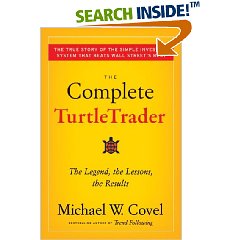
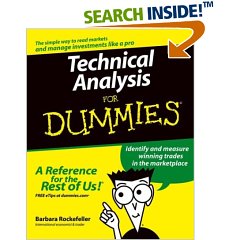 Technical Analysis for Dummies -A simple, straightforward guide to the fundamentals of technical analysis. For active traders and investors who don't understand the complicated art of
technical analysis, this commonsense resource covers all the bases. Explaining the basic principles of analysis and showing how to implement them, Technical Analysis For Dummies dumps the
confusing jargon and unreadable charts for basic explanations and practical guidance. In no time at all, readers will see how to make better trading decisions. Barbara Rockefeller (Stamford, CT)
is one of the foremost authorities on technical analysis and founder of Rockefeller Treasury Services.
Technical Analysis for Dummies -A simple, straightforward guide to the fundamentals of technical analysis. For active traders and investors who don't understand the complicated art of
technical analysis, this commonsense resource covers all the bases. Explaining the basic principles of analysis and showing how to implement them, Technical Analysis For Dummies dumps the
confusing jargon and unreadable charts for basic explanations and practical guidance. In no time at all, readers will see how to make better trading decisions. Barbara Rockefeller (Stamford, CT)
is one of the foremost authorities on technical analysis and founder of Rockefeller Treasury Services.
Archived Charts
Forex Income Engine
DecisionBar Trading Software
Tradestalker Options Trading
Angie's List Review
Options TradingTrainer Review
TradeStalker Trading System
Forex Income Engine 2.0